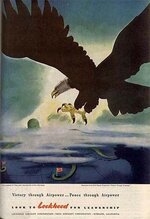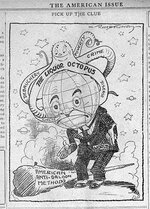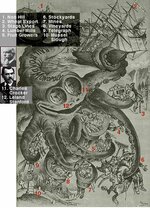- Joined
- Apr 6, 2003
- Messages
- 1,839
Avast Phil,
Thank you so much for posting that image. Seems Disney wasn't constrained by notions of culturally specific animals, as Uncle Walt supplied octopus mascots for American forces, as well.
Note that the Imperial Japanese octopus is green; the more corrosive wartime propaganda and cartoon images of the Japanese people often depicted them as yellow or green-skinned. (However, the octopus Disney produced for the crew of a US Navy submarine was also green.) Note too the octopus' arm stretched out to Alaska's Aleutian island chain. That seldom-remembered theater of war saw the Japanese occupy several islands in June of 1942: Attu, later the scene of vicious fighting between the entrenched invaders and returning American forces (May, 1943), and Kiska, which was evacuated by the Japanese in advance of American efforts to reclaim it (in August of 1943).
But, what are those islands in the octo's arms? Oahu? Midway? Are those the flags of the Rising Sun on them? Midway was saved from the Imperial Japanese Navy on 4 June, 1942, (just days before Kikska and Attu were successfully attacked) and Oahu, though it did receive the attention of a few long-range IJN flying-boats, was never the target of a large-scale attack after 7 December, 1941. This Lockheed poster, then, shows the moment the tide turned in the Pacific: June 1942, and the strategic reversal of Japanese expansion, which was effected largely by a few American Navy dive-bombers at the Battle of Midway. Sadly, the lone eagle couldn't be everywhere, and the two Aleutian islands were taken.
By a huge green octopus.
Clem
Thank you so much for posting that image. Seems Disney wasn't constrained by notions of culturally specific animals, as Uncle Walt supplied octopus mascots for American forces, as well.
Note that the Imperial Japanese octopus is green; the more corrosive wartime propaganda and cartoon images of the Japanese people often depicted them as yellow or green-skinned. (However, the octopus Disney produced for the crew of a US Navy submarine was also green.) Note too the octopus' arm stretched out to Alaska's Aleutian island chain. That seldom-remembered theater of war saw the Japanese occupy several islands in June of 1942: Attu, later the scene of vicious fighting between the entrenched invaders and returning American forces (May, 1943), and Kiska, which was evacuated by the Japanese in advance of American efforts to reclaim it (in August of 1943).
But, what are those islands in the octo's arms? Oahu? Midway? Are those the flags of the Rising Sun on them? Midway was saved from the Imperial Japanese Navy on 4 June, 1942, (just days before Kikska and Attu were successfully attacked) and Oahu, though it did receive the attention of a few long-range IJN flying-boats, was never the target of a large-scale attack after 7 December, 1941. This Lockheed poster, then, shows the moment the tide turned in the Pacific: June 1942, and the strategic reversal of Japanese expansion, which was effected largely by a few American Navy dive-bombers at the Battle of Midway. Sadly, the lone eagle couldn't be everywhere, and the two Aleutian islands were taken.
By a huge green octopus.
Clem







 !!!!!
!!!!!
